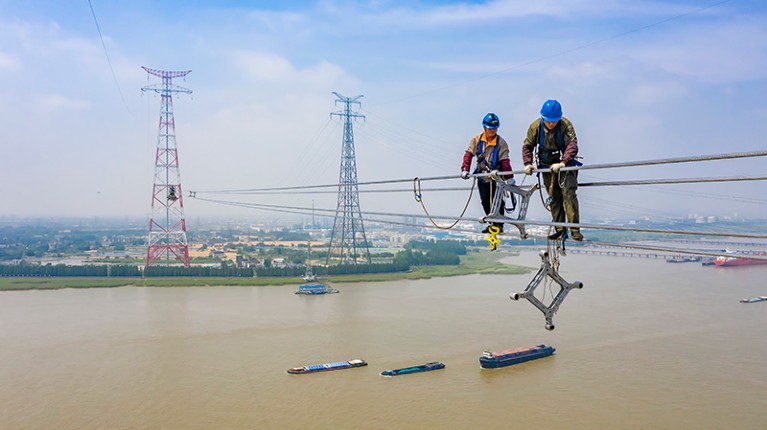
Spanning the Yangtze River with an ultra-high voltage power line exemplifies the scope of China’s technological enterprise.Credit: Shi Jun/VCG via Getty
By applying certain research metrics, it is possible to argue that China is either close to becoming the world’s leading research power or has already achieved this mark. According to many popular measures of research volume, the country is now ahead of the United States on annual peer-reviewed publication output. Suggestions of a lead on research quality are also beginning to emerge. A 2022 report from Japan’s National Institute of Science and Technology Policy, for instance, puts China’s share of the top 1% most-cited papers — based on a fractional count of author affiliations — at 27.2% for articles published between 2018 and 2020, compared with 24.9% for the United States.
In the latest annual tables for the Nature Index, which tracks research output in 82 high-quality natural-science journals, the United States still leads China on Share, a metric that also uses fractional counting of author affiliations. But the gap halved from a Share of more than 6,000 in 2020 to around 3,000 in 2021. The leading institution in the tables, the Chinese Academy of Sciences, also continues to rise in Share, whereas non-Chinese institutions in the top 10, including Harvard University, Stanford University, Germany’s Max Planck Society and France’s National Centre for Scientific Research, all fell, as measured by adjusted Share.
However, China is still some way behind other leading research nations when it comes to widely used measures of innovation. It is still outside the top 10 in the World Intellectual Property Organization’s Global Innovation Index (GII), which ranks economies on a basket of metrics, behind Asian powers such as South Korea and Singapore. According to the report accompanying the 2022 GII, China leads in patents by origin, trademarks, industrial design and the size of its domestic market. However, the report identifies as “weaknesses” China’s regulatory environment, which includes the rule of law and environmental performance. China is also ranked well below the top 50 for GII metrics related to international relations, such as student numbers from abroad, joint ventures and foreign direct investment.
Nor do Chinese institutions appear in this Nature Index supplement’s list of the leading 50 organizations for innovation, based on how often they are cited by patents, although factors such as the time lag in patent-citation analyses and lack of local language coverage could be potential reasons. Outside the top 50, the highest ranked institution, the Hong Kong University of Science and Technology (HKUST) at 53, is based in the special administrative region of Hong Kong, outside China’s main higher-education and research system.
Catch-up economy
So what is holding Chinese innovation back? Is China’s progress in this area simply taking longer because it needs more time for recent successes in basic research to be translated into real-world impact?
China is a ‘catch-up’ economy, according to Marina Yue Zhang, a social scientist in innovation and entrepreneurship studies at Swinburne University of Technology in Australia and co-author of a new book, Demystifying China’s Innovation Machine.
“Innovation capability building is a gradual and cumulative process by which latecomers expand their knowledge base in both scope and depth,” she says. However, she adds, “China has grown into one of the world’s major innovation leaders in a number of areas” with innovation policy playing an “important role”. For instance, it is more than 40 years since China’s ‘reform and opening’ policy, first announced in 1978, to transform it from an agricultural nation to an industrial giant. Since then, its GDP has skyrocketed, from $205 billion in 1982 to $17.7 trillion in 2021. And although China is not in the GII top 10, it is the top-ranked country in the GII’s upper middle-income bracket.
Leading Chinese institutions in innovation
These 10 institutions had the highest patent influence for research publications published between 2000 and 2020. Their Share and Count in the Nature Index for 2021 are also shown.
| Rank | Institution | Patent influence metric | Share 2021 | Count 2021 |
|---|---|---|---|---|
| 1 | The Hong Kong University of Science and Technology | 0.4139 | 120.09 | 446 |
| 2 | The Chinese University of Hong Kong | 0.2478 | 118.18 | 457 |
| 3 | ShanghaiTech University | 0.2383 | 72.05 | 299 |
| 4 | The University of Hong Kong | 0.2341 | 129.22 | 516 |
| 5 | China Pharmaceutical University | 0.2232 | 39.98 | 70 |
| 6 | City University of Hong Kong | 0.2121 | 107.70 | 333 |
| 7 | Tsinghua University | 0.2113 | 472.49 | 1,480 |
| 8 | East China University of Science and Technology | 0.2083 | 117.05 | 278 |
| 9 | University of Science and Technology of China | 0.1861 | 502.50 | 1,444 |
| 10 | Beijing University of Chemical Technology | 0.1853 | 97.79 | 201 |
The challenge for China is how to shift away from what Zhang calls “ranking-driven catch-up models that focus on short-term incentives” such as journal publications and instead pursue “long-term knowledge accumulation based on academic curiosity and freedom”. Basic research made up just over 6% of R&D expenditure in China in 2021, according to the Chinese Ministry of Science and Technology. In comparison, basic research made up more than 15% of US R&D spending, according to a 2022 US congressional report. Of that basic research in China, more than 96% was conducted by public institutions such as universities, meaning that less than 4% was carried out by private enterprises, Zhang says. “These numbers may suggest why China achieved more in academic publications, but is less impressive in innovation,” she explains.
One reason for the disparity, according to Zhang, is that as the Chinese economy boomed over the past decades, R&D expenditure was “driven by economic return” with companies preferring to invest in applied science owing to its more certain monetary gain. This tactic “works fine if you are ‘catching up’ with a clear target in sight. However, when China approaches the frontier of certain technologies,” she argues, “they need to invest in basic science.” She points to semiconductors and biopharmaceuticals as two high-tech industries in which China is caught between disparate levels of applied and basic sciences. In semiconductor development, a complicating factor is also political tensions between mainland China and Taiwan, which controls around 92% of the manufacturing capacity for the world’s most advanced semiconductors — chips of less than 10 nanometres.
But despite such challenges, Futao Huang, an educationalist at the Research Institute of Higher Education at Hiroshima University in Japan, is still cautiously optimistic about Chinese innovation. “There is little doubt that China will continue to boost its ranking in the Global Innovation Index and catch up to its research prowess, because China will definitely increase the gross rate of higher-education enrolment, the number of researchers, as well as R&D investment,” Huang says. He acknowledges that there will be hurdles. “On one hand, China needs to realize the quantitative expansion of higher education, especially researchers with creativity. On the other hand, China needs to make more notable progress in political, regulatory and ecological environments,” he adds.
Cooperation is ‘crucial’
Even if China can fix some of the fundamental domestic challenges that have thwarted its innovation capacity, it faces a major challenge on international collaboration, which has been hit by both COVID-19 travel restrictions and geopolitical tensions. China–US co-publications, which had been on the rise since 2017, fell slightly in 2021, according to a report by Elsevier and the Association of Pacific Rim Universities (APRU). Although the decline was small, the trend was significant enough for the APRU — a group of 60 universities on both sides of the Pacific — to issue a statement about the importance of maintaining ties.
Zhang says that managing geopolitical tensions will be the largest challenge China faces in catching up on innovation. The risk is that a decoupling in technological advancement between China and countries such as the United States leads to the former being cut out of the global innovation ecosystem.
Huang says that it could be challenging for China to attract talent from abroad if the country seems more isolated. This could even include returning overseas Chinese citizens who have trained abroad, a group that China has been hugely successful at luring back in recent years. As a result, he suggests that China may need to look internally, and make more effort in providing favourable environments for domestic researchers with potential, especially the young.

A Nanchang workshop for semiconductors, an industry in which China is seeking rapid growth.Credit: Costfoto/Future Publishing via Getty
An exacerbating factor for China’s international collaboration difficulties has been COVID-19, with borders largely closed to non-Chinese citizens since early 2020. It means almost no foreign academics have been able to visit for conferences or field research. As of September, many students enrolled at Chinese universities, including research postgraduates, were still unable to return, according to the China International Student Union and media reports. One study said that the number of European researchers working in China fell by one-third since the pandemic began (X. Xu et al. Eur. J. High. Educ.12, 416–433; 2022).
Domestic travel restrictions too have been a problem, particularly affecting two areas designated as tech hubs and regional centres for innovation. One is the Yangtze River Delta hub, centred around Shanghai, which was locked down for much of the first half of 2022. Connections to the rest of the hub — the three neighbouring provinces of Zhejiang, Jiangsu and Anhui — were limited. The second is the Pearl River Delta hub, which joins Shenzhen and Guangzhou on the mainland China side of the border with the two special administrative regions of Hong Kong and Macau. Also known as the Greater Bay Area, or GBA, the hub was envisioned as China’s answer to the San Francisco Bay Area, with its cluster of universities and Silicon Valley tech companies, on the west coast of the United States.
Travel has been so difficult between Hong Kong and Shenzhen — two cities barely an hour apart on the subway — that the government had to open a special immigration channel to ease passage for cross-border students. Even the head of Hong Kong’s government, chief executive John Lee, postponed his trip to the opening of HKUST’s new Guangzhou campus in August amid COVID-19 restrictions.
Yang Rui, dean of the Faculty of Education at the University of Hong Kong and a co-investigator on a research project assessing the role of universities in building an innovation and technology hub in southern China, says even without the COVID difficulties, hubs such as the GBA are still in the early stages. He said that the GBA had “a long way to go” in comparison with California, for example. “But the potential is there,” he adds.
The idea behind the GBA is to pair Hong Kong’s knowledge and higher-education excellence with the mainland’s vast land and human resources. But in Yang’s view, the way to stimulate faster growth would be for these large-scale projects to home in on addressing larger societal issues. “In general, those hubs can create an environment where innovation is needed and provided by universities, the industry and the wider society,” he says.
Such an approach could also help international collaboration with China to be rekindled too, according to Christopher Tremewan, APRU’s secretary general, who says that “despite political tensions, international scholarly collaborations in science remain crucial to addressing challenges such as the pandemic and the threat of accelerating climate change”.
With successful innovation being the ability to create impact in economic or social progress, China’s ability to fulfil its potential could rest on how it trains its academic research prowess on wider global challenges in the next five to ten years.
